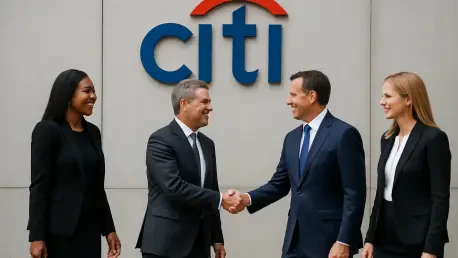What happens when a titan of global banking loses a key architect of its financial strategy at a critical moment of transformation? Citi, one of the largest financial institutions in the U.S., stands at such a crossroads as Chief Financial Officer Mark Mason steps down. His departure, effective early March, marks not just a change in leadership but a test of the bank’s resilience amid sweeping reforms. This pivotal shift raises questions about who will guide Citi through its next phase and how they will navigate the complex landscape of regulatory pressures and ambitious goals. The stakes couldn’t be higher for investors, employees, and the broader financial world watching closely.
A Critical Juncture: Why This Shift Commands the Spotlight
The exit of a CFO is rarely just a personnel update—especially at an institution like Citi, where financial strategy underpins a global operation. Mark Mason’s tenure since 2019 has been defined by steering the bank through turbulent times, making his departure a moment of reckoning. With a massive reorganization underway, including plans to cut 20,000 jobs by 2027, the incoming leader must maintain momentum while addressing investor expectations. This transition isn’t merely about numbers; it’s about sustaining trust in an era of intense scrutiny.
Beyond the balance sheets, Mason’s role as a prominent Black executive in finance adds a unique dimension to this change. His influence has been felt not just in boardrooms but as a symbol of diversity in a historically homogeneous industry. As Citi pivots, the spotlight intensifies on how this shift could influence the bank’s culture and public perception at a time when every decision is magnified.
The Weight of Change: Why Timing Amplifies the Impact
Citi’s journey in recent years has been anything but smooth, grappling with regulatory challenges and the need to modernize outdated systems. Mason played a central role in crafting a two-year overhaul plan, focusing on simplifying operations and addressing consent orders from 2020 through tech upgrades. His departure comes as these initiatives are still in progress, heightening the urgency for a seamless handover. The financial sector watches to see if the new leadership can uphold these commitments without faltering.
Moreover, the broader context of Citi’s ambitions under CEO Jane Fraser adds pressure to this moment. With goals to boost returns and shed legacy burdens, the bank is under a microscope from Wall Street to Main Street. Consumer confidence and market stability hinge on how effectively the next CFO can align with Fraser’s vision while tackling ongoing cost-cutting measures. This isn’t just a corporate shuffle—it’s a litmus test for Citi’s future viability.
Inside the Transition: Key Figures and Bold Strategies
At the heart of this leadership pivot is a carefully orchestrated plan to ensure continuity while embracing change. Mark Mason, after seven years as CFO, leaves a legacy of navigating Citi through transformation, from slashing inefficiencies to bolstering tech infrastructure. His new role as executive vice chair and senior adviser to Fraser keeps him in the fold, guiding strategy through critical events like the Investor Day on May 7. This arrangement signals a deliberate effort to bridge past achievements with future aspirations until he seeks external roles by 2027.
Stepping into the CFO position is Gonzalo Luchetti, whose track record in leading U.S. personal banking offers a glimmer of promise. Under his stewardship, that division achieved a return on tangible common equity of 14.5%, a metric that speaks to his strategic acumen. His analytical prowess will be tested as he takes on broader financial oversight, with the task of driving performance across Citi’s vast operations. Luchetti’s appointment isn’t just a promotion—it’s a bet on his ability to build on Mason’s foundation.
Parallel to this, Citi is reshaping its structure with a merger of the retail bank into the wealth division under Andy Sieg, led operationally by Kate Luft. Simultaneously, the rebranding of U.S. Personal Banking to U.S. Consumer Cards under Pam Habner, who now joins the executive team reporting to Fraser, underscores a push for streamlined profitability. These moves collectively aim to sharpen focus on core businesses, but their success depends on how well new leaders integrate these ambitious restructurings into daily execution.
Voices of Assurance: Leadership Weighs in on the Path Ahead
Confidence radiates from the top as Citi’s leadership frames this transition as a strategic evolution rather than a disruption. CEO Jane Fraser has lauded Mason as an indispensable partner whose integrity shaped the bank’s direction, emphasizing that his advisory role will smooth the shift. Her words carry weight, reflecting a calculated effort to reassure stakeholders that experience remains close at hand during this pivotal period.
On Luchetti, Fraser’s endorsement is equally robust, pointing to his proven results in personal banking as a predictor of success in the CFO suite. Industry observers echo this optimism, noting that Fraser’s recent elevation to chair, coupled with a significant equity award, projects stability at the executive level. Public statements from Citi paint a unified picture, positioning these changes as a refresh that aligns with long-term goals rather than a cause for concern.
Charting the Course: Priorities for Citi’s New Guardians
As Citi’s leadership evolves, the incoming team faces a clear set of imperatives to sustain growth. First, maintaining the momentum of Mason’s reorganization plan is non-negotiable, with Luchetti tasked to oversee remaining headcount reductions and tech enhancements through 2027. Transparent updates, especially at forums like Investor Day, will be crucial to keep investors and analysts aligned with progress on these fronts.
Equally vital is strengthening restructured divisions like retail, wealth, and consumer cards under leaders like Sieg and Habner. Tailoring customer offerings through data-driven insights while trimming operational fat can elevate returns in these areas. This requires not just strategy but relentless execution to ensure these units don’t become bottlenecks in Citi’s broader ambitions.
Finally, rebuilding and retaining investor trust stands as a cornerstone for the future. Luchetti must prioritize clear communication on financial targets, leveraging metrics like return on equity to demonstrate progress. In a competitive banking landscape, every decision will be scrutinized, making it essential for Citi’s leaders to balance bold innovation with the stability Mason helped cement over his tenure.
Reflecting on a Milestone: Lessons and Next Steps
Looking back, Citi’s leadership transition unfolded as a defining chapter, blending the weight of Mark Mason’s transformative legacy with the promise of fresh perspectives under Gonzalo Luchetti. The structural shifts, from merging retail and wealth divisions to redefining core businesses, revealed a bank determined to adapt despite daunting challenges. Each move was calculated to preserve momentum while addressing past inefficiencies.
What emerged was a blueprint for resilience, one that other institutions might study as they face their own crossroads. For Citi, the next steps involve a steadfast commitment to transparency, ensuring stakeholders remain informed through every phase of change. Leaders must prioritize not just financial metrics but also the trust of employees and clients, recognizing that lasting success depends on unity.
Beyond immediate goals, there is a broader imperative to innovate relentlessly, anticipating market shifts before they become crises. Citi’s journey reminds the industry that transitions, though fraught with uncertainty, offer opportunities to redefine purpose. The challenge is to harness this moment, turning potential pitfalls into stepping stones for a stronger, more agile future.









